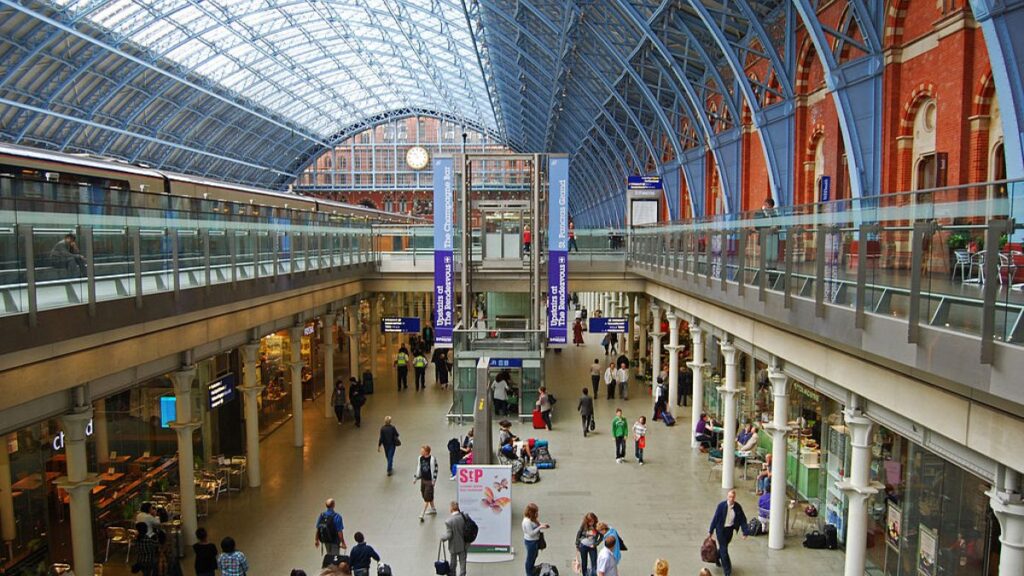London St Pancras station would almost triple its capacity to deliver new train services to Europe by 2030.
You could soon be able to travel by direct train from London to cities like Frankfurt and Zurich.
International high-speed rail travel from Britain to the rest of Europe is on track to become faster, more affordable, and more convenient by 2030.
London St. Pancras Highspeed (formerly HS1) has agreed to work with Eurotunnel on a strategic partnership to boost high-speed rail connectivity between the UK and Europe.
The plan hopes to incentivise more train operators to develop new routes to and from the British capital, reducing journey times and improving timetable coordination.
New train operators brought on to rival Eurostar could even mean international rail passengers can bring their pets on board, something that isn’t currently permitted.
A giant boost for ‘rail-first’ travel in Europe
London St. Pancras Highspeed and Eurotunnel have announced a partnership that they call a “pivotal step” in speeding up the growth of high-speed rail on both sides of the English Channel.
Eurostar, which celebrated its 30-year anniversary in 2024, currently holds a monopoly on trains that run through the Channel Tunnel. Operated by Eurotunnel, the Channel Tunnel is the world’s longest undersea tunnel. It allows millions of passengers and freight vehicles to travel between the UK and France each year.
The aim is “to make rail travel the preferred transport option to the continent,” according to a statement announcing the partnership. Both parties have said they will “actively collaborate” with governments on the environmental benefits of rail journeys under six hours.
The news follows a new study showing that St. Pancras has “untapped potential” and could increase existing international passenger capacity from 1,800 by up to nearly 5,000 people per hour.
London St. Pancras Highspeed is currently the UK’s only international high-speed rail line. It directly connects London to Paris, Brussels, and Amsterdam and offers some seasonal ski services to the French Alps.
This plan could allow access to new train routes between London and major European cities such as Frankfurt, Zurich, and even Milan.
“Joining forces with Eurotunnel is another exciting step on our journey to realise a future where high-speed rail is the preferred option for travelling to Europe,” says
Robert Sinclair, CEO of London St. Pancras Highspeed.
Sinclair adds that the two companies, as key infrastructure managers, can unlock the potential of a “fully connected Europe.”
Infrastructure is one part, but train operators also need to get on board
High-speed train travel between the UK and Europe reduces annual emissions equivalent to 60,000 short-haul flights (pr 750,000 tonnes of CO2) each year, according to research published by London St. Pancras Highspeed.
“We are keen to drive forward attractive opportunities for low-carbon mobility with a range of new destinations in Germany, Switzerland and France,” adds Yann Leriche, CEO of Getlink, the company behind Eurotunnel.
However, Mark Smith, a former rail industry worker who runs the popular train travel guide website Man in Seat 61, explains that this is only the first step in improving international train services.
“We have to remember that these aren’t plans by a train operator to actually run trains. They are suggestions from infrastructure owners about what trains a future unspecified operator may or may not care to run. There’s a big difference!” says Smith.
Smith says that Getlink and HS1 have “capacity to spare”, which is why they are “preparing the ground” and “simplifying processes” to encourage new operators to compete with Eurostar on its existing routes. He adds that rail-on-rail competition is often more effective at “keeping the lid on prices” than competing with other transport modes.
Which new European train routes could connect with London?
Several operators are seeking to capitalise on the station’s planned expansion, including the Virgin Group, and new Spanish operator Evolyn, which was set up by investors in the UK coach company National Express.
Smith says both operators are “credible contenders” that “are most likely to be interested in the airline-competitive routes between London and Paris, Brussels and Amsterdam.” These journeys are in the two to four-hour range.
He also says that a London-Cologne-Frankfurt route is a “realistic possibility”. But it’s dependent on whether “secure platforms and suitable terminal space can be found in Cologne and Frankfurt”.
“We’re talking 2029 or, more likely, 2030 at the earliest.”
A Eurotunnel spokesperson told Euronews Travel that “customer demand for new destinations is clear and real”. They shared market research the company carried out that shows Brits are actively seeking travel by train to Germany (Köln, Frankfurt), Switzerland (Geneva, Zurich), and the South of France (Marseille, Bordeaux).
Other possible proposed routes, such as London to Geneva or Milan, says Smith, would likely be ruled out for commercial and operational reasons, even if passenger demand exists.
Looking ahead to the future, he believes that a new operator to rival Eurostar could bring a new dawn in “simpler and more easily-booked arrangements for cyclists” and “allow pets [to travel] under the PETS travel scheme”, which Eurostar doesn’t currently allow.
Read the full article here

